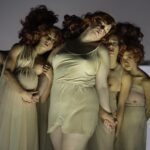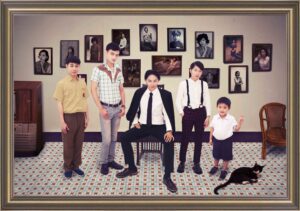
by
Connie Wolf, the longtime former head of the Contemporary Jewish Museum, started the new year with a new job as the John and Jill Freidenrich director of Stanford University’s Iris and B. Gerald Cantor Center for Visual Arts.
She followed the footsteps of the center’s founding director Thomas K. Seligman, who retired last year after a 20-year career at the Cantor Arts Center, says Matthew Tiews, executive director of arts programs for the School of Humanities and Sciences at Stanford and one of eight members on Wolf’s hiring committee.
CJM hasn’t announced who will fill Wolf’s shoes. The museum’s board formed a search committee last July, chaired by Mark Schlesinger.
Connie is excited about the change, she said, but she never truly left Stanford. Throughout her career she stayed in touch and at times worked on community projects at her alma mater.
A hallmark of her career that she’s most proud of is the deepening of the relationships and partnerships she’s developed throughout the Bay Area and beyond over the years, she said. She imagines she will have a similar relationship with CJM as a “member and a supporter,” calling the museum’s community her “friends and family.”
Full circle
“There was something very organic about the shift … Stanford has always held a very, very important part of my life,” says Connie, who obtained a bachelor’s degree in East Asian studies from the university in 1981.
“So, to go from a place that I feel so passionate about … and so committed to, then moving to Stanford that holds a certain weight for me … the connection is very authentic and very present,” says Connie.
Tiews and Wolf declined to state what her new salary is or the center’s budget. Connie’s last day at CJM was December 2.
Connie, 51, an out lesbian, stepped into her former role as chief executive officer of CJM in San Francisco 12 years ago, when the museum was still housed at the base of the Jewish Community Federation on San Francisco’s Embarcadero.
Connie returned to the San Francisco Bay Area, settling in the gay mecca, to lead CJM after stints in New York. She was the associate director for public programs and curator of education at the Whitney Museum for American Art. At the Rockefeller Foundation she was a research associate in school reform and a Warren Weaver Fellow in the arts and humanities division. She also held posts at Boston’s Museum of Fine Art and the Museum of Contemporary Art in Los Angeles.
Through her leadership CJM grew from a small staff of six to 60, a robust 41-member board of trustees, and she moved the museum out of its humble community-based home into its modern $85 million location in the heart of San Francisco’s art district in 2008.
Under her deft vision, she placed the museum on the map as an artistic and cultural destination with significant exhibits featuring Harry Houdini, Gertrude Stein, Marc Chagall, Andy Warhol, Margret and H.A. Rey, to name a few within the past three years.
Since its founding in 1984, the museum has commissioned more than 125 new works of art, staged more than 20 exhibitions, and welcomes nearly 125,000 visitors annually, reported j., the Northern California Jewish weekly magazine.
Wolf also insured the future of the museum by establishing a $25 million endowment, reported Stanford Report in July announcing the change of the Cantor Arts Center’s leadership.
“We were able to really think afresh about the program and the exhibitions and the role that we wanted to play in this community,” says Connie, about her accomplishments at CJM.
She feels the foundation was set in making CJM an institution that engages the local community as well as the many visitors who come to San Francisco yearly.
“I feel really proud, like anything that grows up in the world it is standing strong and firm and will go on to great things,” says Connie.
Once an ‘outsider’
One of only seven Jews in her high school class of 300 in Grand Rapids, Michigan, Wolf knows what it feels like to be an “outsider” and “excluded,” she told the Bay Area Reporter in 2008.
The outsider was left behind when she stepped into Stanford’s diverse world.
Wolf doesn’t wave the big “L” on her unique position of being one of the few openly lesbian directors in the male dominated art field. She is waiting for the day when “no one has to ask these questions,” she said, claiming that she never encountered homophobia or sexism personally.
“Being a lesbian has never been a barrier. I don’t let it be a barrier,” she says.
She is much more focused on her work than her gender, religion, or sexual orientation.
“I want to be judged on what I accomplish. I want to viewed and be valued for what I do,” she says.
Yet, a hint of the outsiderness and the diverse world she entered in her youth remains in the form of emphasizing “inclusiveness and tolerance” at the institutions she’s led.
Most recently, this was displayed when Wolf hosted a “Hand Holding Day” at CJM that brought out the LGBT community. The San Francisco Lesbian/Gay Freedom Band performed “I Want to Hold Your Hand” at the event in response to a homophobic incident at the museum last summer.
In July, a lesbian couple was asked to leave the museum while viewing the Gertrude Stein exhibit by a contract security officer from Guardsmark, who reportedly told the two women that holding hands wasn’t allowed. The irony – Stein was a lesbian and the partner of Alice B. Toklas – wasn’t lost on local residents.
In addition to Hand Holding Day, sensitivity training for San Francisco Guardsmark security officers was also conducted, says Connie and Daryl Carr, a museum spokesman.
Guardsmark repeatedly shuffled the calls inquiring about the lesbian, gay, bisexual, and transgender sensitivity training back and forth between its headquarters in New York and its San Francisco office without a response.
In 2008, when asked why she loves artists and the arts, Connie responded that artists ask “you to think about the world from a different perspective, and to be respectful of others.”
“I want every visitor to feel included, no matter where they’re from. I want them to feel safe, to feel welcome, that they’re in an environment where they can explore and think out of the box,” says Connie.
Change of pace
Wolf is excited about her new position at the Cantor Arts Center. The center is Stanford’s “centerpiece” as the university reaffirms its commitment to being a leader in the artistic community, she says.
The center is the leading academic art institution and the most visited university museum in the country, according to Wolf. Last year, Stanford acquired the Anderson Collection, one of the most outstanding private collections of 20th century American art in the world, among its other works of art in its impressive collection.
In addition to the art acquisition, it announced the Diller Scofidio and Renfro firm as the architect of the McMurtry arts building, which will be the new home of the university’s art and art history department.
Stanford has long been an innovative leader in art since before the university’s founding. Railroad baron Leland Stanford had an interest in arts and technology. He hired photographer Eadweard Muybridge who produced the iconic photographs of movement at Stanford, the university’s museum was a part of its original grand scheme, and today the university boasts its Center for Computer Research for Music and Acoustics among its other talents, says Matthew.
“Museums are very important places for scholarship and research,” says Connie, who believes that museums in an academic environment provide a “unique experience looking at art” and creating art in a “very different way,” especially being in the heart of the technology center of the world.
Wolf’s artistic goals and vision were in line with the university’s initiatives for the 21st century, Matthew says. Connie’s energy, innovation, and success at CJM as well as her profound love for the arts and the Bay Area’s artistic community made her a star with committee members.
“We are really looking at the way that we are moving art to the forefront of what we do,” Matthew says about the new art district being created at the entrance to Stanford.
Connie is most interested in “connecting people with ideals and art,” she says.
“I don’t have a prescribed path that I want to take us on, rather I want to make sure the questioning and discussion is always vibrant and always alive. So, as technology advances in the ways in which we learn and experience and connect that the museum is a step ahead and always there to facilitate that,” Connie says about her goals for the museum.
Whatever Connie’s plans, the public will have to wait. Like most museums, the center’s exhibition schedule is already mapped out for the next two to three years. Wolf’s primary goal this year will be to learn as much as she can about the institution to help her envision its future.
To learn more, visit http://museum.stanford.edu/.
Originally published by the Bay Area Reporter.







